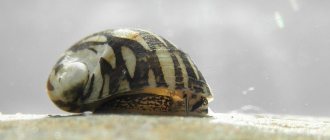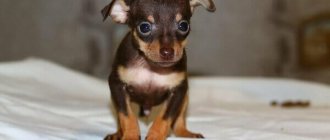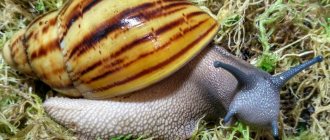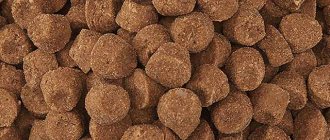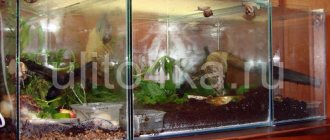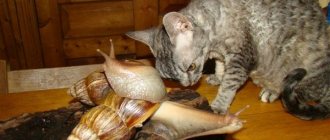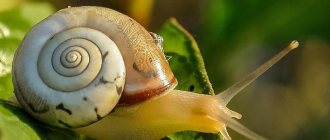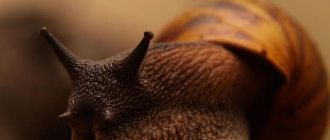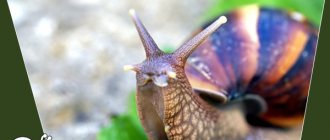Lighting
Akhatina has poor vision; she only distinguishes between day and night. Therefore, it is not necessary to install lighting in the snail's terrarium or container. This is more needed for monitoring two-horned pets and plant growth. Only the incandescent lamp needs to be taken outside the container or aquarium so that the snail does not get burned.
Temperature and humidity content
All Achatina are residents of tropical countries, so the optimal temperature for keeping them is considered to be from 24 to 28 degrees. At very high air temperatures, snails feel unwell, hibernate and may even die. There is no need to place snails on the windowsill or near the radiator.
Many snail breeders use thermal mats or a thermal cord, since the room temperature for a mollusk is very low. However, heating devices must be placed on the outside of the container. Humidity is also a prerequisite for a snail to live comfortably.
The humidity in the terrarium is maintained by daily irrigation of the soil, as well as by placing a shallow container of water. To determine humidity, a hygrometer is placed in the terrarium, but sphagnum moss can successfully replace it. If it is green and the snails are not constantly on the walls of the container, then everything is in order with humidity. If the moss turns yellow, the air needs to be humidified.
The main rules for communicating with a snail
There are several rules that must be strictly observed when communicating with Achatina.
- The first rule: communication with Achatina must be started with clean, wet hands. Hands must be washed with soap and rinsed thoroughly so that no soap marks remain on your hands. Also, there should be no traces of cream, aromatic oils, etc. on your hands.
- The second rule: do not touch or pull the sink with your hands. Achatina sticks to the walls of the home very tightly. If you try to tear it off by taking it by the shell, the snail may remain on the wall, and its shell in your hands. This is practically death for the animal. Therefore, before picking up your pet, you need to spray it with a little water, and use a wet finger to touch its face and the front of its leg. Achatina will crawl onto a wet hand and unstick the rest of the leg from the wall of the aquarium. Also, you should not touch the growth, as it can easily be damaged. Then the further formation of the shell will occur with disturbances, it will become covered with scars.
- Third rule: you cannot forcibly pull Achatina out of the shell, as you can damage not only its house, but also Achatina’s body.
- Fourth rule: children should not be allowed to play with snails without supervision.
- Fifth rule: after interacting with your pet, be sure to wash your hands with soap. All gastropods are carriers of parasites. You can get infected through dirty hands. This is especially true for children.
Health, disease and prevention
A number of factors influence the health of a snail, such as:
- Maintenance problems associated with hypothermia or overheating of shellfish. Confinement in cramped housing, using either dry or too wet soil.
- Nutritional problems when shellfish are fed low-calorie foods that contain insufficient amounts of protein and calcium.
- Problems with living conditions associated with unsanitary conditions.
- Poor ventilation and poor quality soil.
- Neighborhood problems when the compatibility of different species is not taken into account.
If a pet refuses food completely or partially, becomes lethargic, becomes clogged in the shell, and various discharges in the form of thick mucus are observed, then this is the first sign that the snail is sick. The disease is also indicated by delamination of the shell. The most dangerous disease is when a gastropod falls out of its shell. Such consequences may be associated either with genetic predispositions or as a result of prolonged exposure to chemically harmful components, bacteria, infections or fungi.
As a rule, in this case the mollusk quickly dies. To protect yourself and your pet from negative processes, you should approach dietary choices wisely.
It is important to know! Thanks to the observance of preventive measures, such as constant monitoring of the cleanliness of the terrarium, adherence to nutritional rules, as well as proper care, it is possible to protect your pet from many diseases.
In case of careless handling of the snail, damage of varying severity may occur, compromising the integrity of the shell. Some damage to the shell can be removed with epoxy glue, but in any case the animal must be provided with food rich in calcium.
If you keep a snail in unsanitary conditions, it may develop parasites or infectious diseases, which require enormous effort to get rid of. To combat such phenomena, propolis-based ointments are used, as well as the drug “Mikoseptin” and iodine solution, which can be purchased at the pharmacy.
How to create a comfortable environment for a snail
Achatina plants do not need bright light to function. The scorching sun is destructive for them. These are nocturnal inhabitants. The main thing is that they feel the change of day and night. Therefore, it is not recommended to keep pets on the windowsill, but a coffee table is a great place. During the day, Achatina can be in the ground or under a leaf, and in the evening it will begin to crawl, eat, and explore the surrounding space with interest.
They also need a comfortable, spacious, moist home with clean bedding. The soil is poured onto the bottom in a thick layer - up to 12 cm. It must be sterile, for this it is:
- washed under running water,
- calcined in the oven at 200°C for 7 - 8 minutes;
- cool down.
The larger the animal, the thicker the layer of soil is needed, since it will bury itself entirely in it.
Achatina Fulika in cooking
Snails have been used as food since ancient times. The Egyptians and ancient Greeks highly valued snail meat for its dietary value. Read recipes from Achatina here. Therefore, during World War II, Achatina Fulica was used as a food reserve for American soldiers. But not only the American military ate the giant snail during the war; the soldiers of the Japanese army also fell in love with it.
In Africa and some cities in Brazil, Achatina is used for religious purposes, as a rich offering to the deity Oxala. In Nigeria, Achatina fulica is revered not only as an offering to the gods, but also as an easily accessible source of protein. All Africans eat the giant snail.
Choosing a container for housing
Before you get an exotic mollusk, you need to prepare a comfortable habitat for it, bringing it closer to natural conditions. You should not keep your pet in a jar or small plastic container. For the normal life of one adult, an aquarium or container volume of 10 to 15 liters is required. Kids, on the contrary, need a small aquarium, as it will be difficult for them to get to food.
In the photo: Terrarium
For snails you can buy:
- aquarium;
- terrarium;
- Plastic container.
There are certain requirements for such containers:
- they must have smooth transparent walls;
- do not use convex containers (round aquarium, jar, etc.);
- You cannot use cardboard, wooden or metal containers.
It is also necessary to arrange a lid with holes so that the Achatina cannot crawl around the apartment or fall and damage the sink. If there is a cat or dog living at home, it is necessary to install the container so that the animals cannot reach its inhabitants.
You cannot decorate the container with hard or sharp objects, which could damage the shell. For drinking bowls, you can take ordinary nylon lids from jars. You can equip your pet with a small swimming pool with low sides so that the animals do not choke.
✅ Terrarium
Suitable terrariums can be purchased at any pet store. Such pleasure is not cheap. They are made from glass or plastic. The price of the product will depend on this. Glass terrariums are not very durable, but they are cheaper than plastic ones. They come in various sizes and shapes. It is best to choose a horizontal terrarium as it is more stable. But the main advantage of such a container is that it is sold with a lid with special holes. Also included is a thermometer. It will help control the temperature.
✅ Aquarium
An aquarium of 15 - 40 liters is suitable for breeding Achatina. This will be enough for two or three large individuals.
For the safety of the inhabitants, the aquarium is covered with a lid made of plexiglass or thick glass with holes for air.
The main disadvantages of an aquarium:
- fragility;
- weighs a lot;
- it is difficult to make holes in the glass lid;
- The glass lid causes inconvenience in caring for animals.
✅ Plastic container
Such a food-grade plastic container with a lid is the best option for Achatina:
- even the largest container weighs little and is easy to clean;
- it is easy to make the necessary holes in the plastic cover;
- the container has handles that help you move the container from place to place;
- the most suitable container for beginner snail breeders.
Physical properties
Achatina is one of the largest land snails. The body size of an adult animal can reach up to 40 cm in length, weight, depending on living conditions, varies from 130 to 550 grams. The spread of this species is strictly controlled in most countries due to the damage they can cause to garden plants.
The snail's shell is large and very dense. It ranges from seven to nine curls. Breathing is ensured through the cavities of the skin, so it has a special lubricant. On the head there are several pairs of large and small horns, which play the role of organs of touch and vision - the eyes are located on the longest ones.
Achatina snails live up to ten years, life expectancy depends on the conditions of detention. Throughout their life cycle, their bodies increase in size. The color of the body and shell differs somewhat depending on the variety, but usually it is brownish-brown, yellowish tones.
Achatina differ in the color of the columella. This is the lower part of the shell, the connection point between the shell and the body. The color in this place can be soft pink, white, blue, even bright crimson.
Soil for Achatina
Preparing the soil for Achatina is a particularly important task. Forest, garden or vegetable soil cannot be poured into the aquarium without treatment. The soil needs to be washed and fried to disinfect it from all viruses, bacteria, parasites and insects. As a rule, all large pet stores sell ready-made bedding for Achatina.
Why do Achatina need soil?
Can't I just release it into a clean container?
While cleaning the main terrarium, it is possible, but for the constant existence of gastropods, soil is vital because:
- it helps maintain the desired level of humidity;
- the snail buries itself in it during the day, hiding from the sun when it lays eggs;
- if Achatina falls from the wall of the terrarium, it will absorb the fall and keep the shell intact.
The litter needs to be looked after promptly:
- change regularly (if it begins to smell unpleasant or becomes moldy, it requires urgent complete replacement);
- the soil can be used several times (rinse it, scald it with boiling water, add a little new);
- in a terrarium where the female has laid eggs, you can carefully change only the top layer of litter;
- Spray with a spray bottle several times during the day;
- make sure that the litter is not compressed, fluff it up so that it is at least 10 - 15 cm thick.
Attention! To make it easier to replace or wash the soil, you can take a plastic bag, the bottom of which is the same size as the area of the terrarium. Place the bag so that the poured substrate adheres well to the walls of the vessel, cut off the excess with a sharp knife.
Feeding
The snail does not require additional care, and feeding consists of cutting vegetables, fruits, and herbs into small slices and placing them in the terrarium. Interestingly, in their native habitat, Achatina does not refuse animal food, so sometimes they can be pampered with chicken or minced meat. Ready-made food from pet stores is also suitable.
As food, snails are given pieces of eggplant, zucchini, cucumbers, sweet peppers, celery or watermelon. These animals should not be fed citrus fruits or other foods that are too acidic.
Fermentation and oxidation products, for example, cottage cheese or grapes, are unacceptable.
Food can be placed in the aquarium once every two to three days. If the owner of Achatina raises young animals, then he should add calcium to his food to promote the growth of a strong shell. Egg shells and high-quality calcekas are quite suitable for this.
This is a special food that is prepared for young animals by mixing several varieties of steamed cereal, wheat bran, gammarus, eggshells, Biovetan, and dry fish food.
Recommended soils
✅ Coconut substrate
It is ideal for keeping gastropods:
- available;
- does not get dirty;
- perfectly absorbs moisture;
- can be coarse, fine-grained;
- Coconut fibers are absolutely safe for gastropods and prevent the proliferation of parasites.
How to use coconut substrate:
- knead a third of the briquette;
- pour boiling water for 20–30 minutes;
- drain the water;
- dry;
- spread in a thick layer of 10 to 15 cm.
✅ Leaf litter
It is mixed with moss and laid on top of the base soil. Does not retain moisture and decomposes quickly. Collected in the fall, stored in a dry place (in a box).
✅ Forest cover moss
It can be easily collected in a park or forest. Before use, it is thoroughly washed from forest debris with settled water (without chlorine), scalded, and soaked in water for several hours. It is laid on top of the main bedding and washed every week. If the moss is green, there is enough moisture; as soon as it dries, you need to irrigate it with water.
✅ Sphagnum moss
Achatina is perfect for keeping Achatina, as it retains moisture, insects do not breed in it, and does not stain animals. Sold in flower shops.
✅ Earth
Natural soil should not contain fertilizers, garbage, or animal feces. Before use, it must be thoroughly washed and roasted in the oven. The cooled soil is mixed with 1 - 2 tablespoons of ground chalk.
✅ Neutralized peat
Advantages of peat:
- inexpensive;
- accessible;
- retains moisture well;
- does not cake.
Flaws:
- Peat only with a pH above 7 is suitable for mollusks, since the acid-base environment leads to burns of the body;
- may contain eggs of helminths and other parasites (before creating the litter, it must be fried for at least 15 minutes).
✅ Hazelnut shells
Crushed nut shells do not absorb moisture well, and water accumulates underneath and quickly stagnates. An unpleasant odor may attract insects. This type of bedding needs to be changed very often, but it does not stain the Achatina and is reliable protection in case of falls.
Features of character and lifestyle
Photo: Giant Achatina
African snails generally lead a sedentary lifestyle, and under favorable conditions they can spend almost their entire life in one place. These snails live mostly alone; they do not do well among a large number of relatives; they experience stress in a crowd. If the snails do not have enough space for comfortable settlement, the mollusks can migrate en masse to another place.
Such migrations mainly occur during times of population surge. These snails are active in the early morning and evening, when it is still cool and there is dew on the grass. Snails are also active during the rains. During the heat of the day, snails rest, hiding from the sun behind stones and tree leaves. Adult snails can sometimes arrange special resting places for themselves, and try not to crawl far from these places. Juveniles are usually not attached to resting areas and can move long distances. Snails are very slow creatures; they crawl at a speed of 1-2 m/min.
Snails often hibernate during the winter. Sensing a drop in temperature, the snail begins to dig a hole in the ground. The burrow can be approximately 30-50 cm deep. The snail climbs into its hole to hibernate and buries the entrance to the hole. She covers the entrance to the shell with an adhesive film consisting of mucus and falls asleep. Achatina emerges from hibernation in the spring. In captivity, Achatina can also hibernate due to unfavorable conditions, illness or stress. You can wake up the snail by simply placing it under a stream of warm water.
Interesting fact: Snails are very good at locating their surroundings and can accurately determine the location of their resting place or burrow.
Prohibited soils
❌ Sawdust
This type of bedding is not recommended by fish breeders, as sawdust (splinters) can injure the animal’s delicate body and esophagus.
❌ Sand
Not recommended due to the abrasive properties of sand. It can injure both the leg and Achatina’s house, get hidden under the sink, and cause discomfort. Once in the esophagus, it can clog the intestines and kill the mollusk.
❌ Pebbles
Small stones and pebbles are absolutely not suitable for lining the bottom of the terrarium. Achatina cannot burrow into it; they can be injured on hard stones if they accidentally fall.
❌ Clay
Pure clay is absolutely not suitable for a snail terrarium. It gets saturated with water, swells, gets dirty, and gets compressed. Once in the snail's stomach, it literally cements everything around it.
Lemon Achatina (Achatina iredalei)
Lemon Achatina - Achatina iredalei
Iradelie comes from Zanzibar. The conical shell measures 6 cm with 4 turns. This species received its name for the lemon-yellow color of the shell and the cream color of the sole. The color of the head is darker than that of the sole. The apex is sandy or yellow, the columella is yellow.
This snail is viviparous (does not lay eggs). It becomes sexually mature at 7 months, and 25 snails, each 1 cm in size, are born every six months.
Akhatina Iradelie
She is active, sociable and curious, unpretentious to the conditions of detention. Loves water and tasty food. 23-28 degrees is the optimal temperature for lemon snail. Humidity 70%-90%.
It is nocturnal, squeaks, rustles and eats. Distinguishes the owner from strangers. She loves to be held. The volume of the terrarium for lemon Achatina is 10 liters.
Varieties of Achatina iradelei:
- Achatina iredalei albino
Achatina iredalei albino
Why does a snail burrow into the ground?
This is absolutely normal behavior of gastropods. Loose bedding is a natural protection for them from bright light. Burying deeper, Achatina thus:
- resting;
- sleeps;
- preparing to lay.
If Achatina is buried, you should not dig it out, since in the evening it will crawl out for a walk and eat. Long-term presence of Achatina under the ground indicates maintenance problems:
- she’s cold, she’s warming herself up like that;
- too dry, she is hot (the terrarium is located close to a heat source, direct sunlight);
To maintain sufficient humidity, it is necessary to regularly spray the soil and walls of the terrarium. This will allow the snail to get out of its hiding place, drink, bathe and warm up.
Where does Achatina Fulika live?
Today, the spread of the snail's range has been stopped only thanks to strict quarantine measures. America was the first to introduce quarantine. Achatina's giant homeland is East Africa, but this mollusk has reached other parts of the world through trade as a food resource and accidental hatch.
This species was found in Xiamen (China) in 1930. Then Achatina went to Pratas (Taiwan Island), then throughout India and the Pacific region, from there to the Indian Ocean islands and the West Indies.
In the United States - in Hawaii and Florida, the most severe destruction of the Achatina snail is underway.
In Europe, due to climatic conditions, the survival of Achatina in nature is impossible; they are kept as pets.
How to decorate the Achatina house
Creating a beautiful, cozy habitat is just as important as creating good living conditions for pets. You can decorate the container, bringing its contents closer to the natural environment. To do this, you can use various accessories, feeders, houses, and live vegetation.
Attention! Wash all driftwood, bark and nut peels before use and rinse with boiling water.
✅ Snail house
A piece of bark, half a coconut peel, a piece of driftwood with a hole in the trunk, and shards from old pots will serve as a house.
✅ Accessories
Many pet stores offer special decor for snails - artificial flowers and coconut holes. They look great and are absolutely harmless to animals.
✅ Vegetation
Living plants will decorate the snails’ home, serve as shelter and an additional source of food. They do well in humid environments:
- tradescantia;
- fern;
- Crassula (money tree);
- ivy;
- wheat;
- oats.
You can put driftwood or tree bark on the bottom. As necessary, they need to be changed along with the bedding.
✅ Drinking bowl, feeder
Small nylon lids from jars, plastic saucers, and stands for small flower pots are ideal for feeders and drinkers.
History of aquarium distribution
Giant snails were first discovered in East Africa, from where they rapidly spread to the south of the continent and Madagascar. Ten years later, Achatina appeared in India, Sri Lanka, China and Malaysia.
In Japan, snail farms began to be created, where mollusks were bred to produce and sell large quantities of Achatina meat.
Due to the great damage that these snails caused - these pests devour garden crops, useful plants, almost everything in their path - in southern Asia people began to actively exterminate these creatures. And in new habitats the problem sometimes takes on even greater proportions. Thus, in the American state of Florida, the damage from these mollusks is so great that importing Achatina into the region is punishable by a prison sentence.
It would be wrong to talk only about the harm that these mollusks cause. They are also orderlies of their kind, destroying rotting and harmful plants, dying trees, animal excrement, and other waste.
In their homeland, Achatina, unlike other places, has a dangerous enemy that regulates the number of snails - the predatory mollusk Gonaxis, so in East Africa there is no question of fighting this pest; the balance is maintained naturally. But in new habitat regions, other dangers to the species have appeared, for example, mice, hedgehogs, moles, birds, and some insects.
In the harsh Russian climatic conditions, the spread of this gastro mollusk in the wild is impossible.
But in addition to harmful and beneficial properties, Achatina has an attractive appearance and their behavior is interesting to observe, so at the end of the 20th century they already began to occupy the niche of aquarium household inhabitants. They are kept as quiet pets that do not cause trouble and do not require special attention.
Environmental conditions
The homeland of Achatina is the African humid tropics, where daytime temperatures can reach 28 - 30°C. Scientists have noticed that these unpretentious and hardy creatures can remain active for a short time even at the lowest temperatures above zero. Some individuals were awake at +2°C. A short-term drop in temperature (for a few hours) will not be destructive for Achatina, but constant cold can quickly destroy them. Keeping Achatina at home requires constant attention.
✅ Temperature in the terrarium
The air temperature that is comfortable for gastropods should be within 24 - 28°C. Usually, in an apartment, Achatina feels quite well. In the off-season, when the apartment becomes cool and there is no heating yet, they need to heat the soil and maintain the humidity level. If conditions are not right, the animal may become lethargic, stop eating and hibernate.
✅ Humidity
Dryness in the terrarium negatively affects the health of its inhabitants. The walls of the terrarium and the soil require regular moistening. A spray bottle for indoor flowers is suitable for these purposes. Several times a day it is necessary to spray the snails and the walls of their home. The humidity level should be at least 70 - 90%. You can learn about it from the behavior of mollusks. If the terrarium is too humid, they will constantly sit on the walls. If Achatina has closed the entrance to the sink with a membrane, then the air is too dry.
When the soil has normal humidity, Achatina burrows into it during the day and crawls along its surface at night. It is enough to moisten the soil with a spray bottle once a day. If there was masonry in the ground and the babies hatched, it is better to transplant them into a container without soil. This way, children will find food faster, and the terrarium will be easier to care for.
A small “pool” will help maintain humidity, in which Achatina enjoys swimming.
✅ Ventilation
It is recommended to close the terrarium with a lid with small holes so that fresh air can enter it. It is also recommended to ventilate it periodically. At the same time, it is necessary to ensure that the humidity remains at an acceptable level.
✅ Lighting
Gastropods have almost no need for sunlight. Natural room lighting is enough for them to determine the time of day and night.
✅ Thermal mat
At normal room temperature, Achatina feels great. It is necessary to heat the air in the terrarium in extreme cases, when the apartment is cold. On such days, you can heat the terrarium using a regular table lamp. You can also install a thermal mat under the terrarium, which will warm the soil and thereby maintain the heat level. When heating, it is necessary to maintain a high level of humidity. You should not overheat Achatina, since at +35°C they can also fall asleep.
Purchasing an Achatina snail: a number of tips
Before buying such a pet, it would be a good idea to familiarize yourself with the care features and also ask what the snail feeds on. It is equally important to know what the features of its content are. Features include:
- It is better to buy a snail at a pet store, but before that it is better to observe how the snail behaves to determine its health. Here you can learn about her gastronomic preferences.
- It is equally important to study the terrarium and its equipment for volume, lighting, ventilation system, etc.
- African snails must be accompanied by special registration documents indicating their pedigree.
As a rule, private individuals who practice breeding land gastropods do not practice culling and try to sell the maximum number of snails. They can implement masonry and do not have all the necessary information regarding care and maintenance. Therefore, you should not expect complete information about the snails they sell. At the same time, they do not particularly care about their health.
It is important to know! The appearance of a mollusk can tell a lot, especially its shell, which must be uniform and free of cracks and other defects. The best option is to buy Achatina after it is at least 2 months old.
Breeders treat the snail breeding process with full responsibility and have all the information about these unique living creatures. Such people do not put profit at the forefront of their activities, therefore they always provide important information, both about the origin of the mollusks and their pedigree. They are constantly engaged in culling and do not practice the sale of clutches for breeding.
Cleaning the terrarium
The health of gastropods and their breeding directly depends not only on temperature and humidity, but also on the level of cleanliness in the terrarium. Achatina owners must adhere to strict hygiene standards in the terrarium.
| Type of cleaning, hygiene procedures | Periodicity |
| Cleaning the terrarium from food debris | daily |
| Wiping the walls of the terrarium with a clean sponge | daily |
| Changing snail filler and washing the terrarium with soda | Once every 2 - 3 weeks |
| Bathing in a shower or bath with warm water | as your pet gets dirty or during general cleaning of the terrarium. |
Achatina diet
The basis of the diet of such mollusks can be lettuce leaves, various greens, shoots of cereal crops, as well as tops. In addition, the following food items should be included in their diet:
- Cucumber and pumpkin pulp.
- Spinach.
- Zucchini.
- Carrot.
- Ears of young corn.
- Peas.
- Tomatoes.
- Cabbage.
- Apple and pear pulp.
- Watermelons and melons.
- Bananas.
- Apricots.
- Avocado.
- Mango.
- Pineapples.
- Cherries.
- Plums.
- Raspberry.
- Strawberries.
Adults are often capricious, giving preference to certain specific foods and refusing others. Despite this, soft food items should be crushed and given in slices, while harder ones should be ground on a grater, as well as in a blender. All shellfish food should be at room temperature.
These pets should not be given food from the table that is included in the human diet. These are fried foods, spices, sweets, smoked foods, and sour foods. Various acids, including natural acids found in citrus fruits, are considered dangerous for shellfish. It is quite important that pets are provided with mineral supplements that contain a sufficient amount of calcium.
Important point! There should always be clean water in the terrarium. Mollusks not only drink it, but also perform water procedures. Therefore, the water needs to be changed daily.
Adult snails feed once a day, preferably in the evening. As for young animals, they must have food on a constant basis, as well as water. Food should be served on a kind of tray, which can be used as a leaf of lettuce or cabbage. If food remains, it is better to remove it from the terrarium.
Snail bathing
Often, novice owners are interested in how to bathe Achatina snails. It should be remembered that shellfish should not come into contact with any types of detergents!
It is not recommended to bathe Achatina under running tap water. Why? There are several reasons for this:
- a wet snail can slip out of your hands and break;
- under a strong stream she may choke;
- Tap water may contain chlorine and other undesirable compounds in concentrations that are harmful to Achatina.
You can bathe your pet in warm (30°C) settled water in shallow containers (saucer, plastic container). The water level should slightly cover the clam's leg. Achatina bathes well on its own in a equipped bath made of a plastic lid, or by collecting drops of water from the walls of the terrarium.
Unscheduled bathing is arranged for pets:
- sick;
- who went beyond the turn;
- very dirty;
- became infected with parasites.
Achatina care
In fact, these living creatures do not require special care, but it is necessary to monitor the condition of their home. As soiling occurs, preventative cleaning is carried out, and general cleaning is carried out at least 2 times a month. At the same time, the inside walls of the terrarium and the lid are washed every day.
Cleaning the shellfish's home should be done using regular hot water and soft rags. It is acceptable to use a regular dishwashing sponge. It is not recommended to use chemicals for cleaning and washing dishes or the like.
It is important to know! Materials, devices and tools used for cleaning, cleaning and washing snails’ homes must be stored in a separate place.
Gastropods regularly take water treatments. In this regard, it is recommended to place a shallow pool in the terrarium. In addition, they need to arrange something like a warm shower. To do this, you need to take the snail in your hand and hold it over the sink. The stream of water directed at the snail should be warm and not strong. The snail is subjected to this procedure for 3 minutes, no more.
SNAIL CARE | Basics of content AKHATINA | ACHATINE SNAILS
How do snails winter?
In nature, all gastropods living in northern latitudes, with the onset of cold weather, go for a seasonal “wintering” - they bury themselves in the ground or in fallen leaves and slam the shell entrance with a special membrane - the epiphragm. They remain in a state of suspended animation until mid-April, when the snow cover finally melts and the temperature rises above 10 - 15°C.
African Achatina can fall into a state of suspended animation, regardless of the change of season, for the entire duration of unfavorable conditions. During hot and dry periods, they drop from plants and hide under fallen leaves in the top layer of soil. As soon as conditions become favorable, the snails crawl back to the surface.
At home, Achatina burrows deep into the ground and falls asleep when:
- the terrarium has become too dry or cold;
- not enough food;
- she was attacked by parasites or insects;
- got stressed (soil, diet, living conditions changed abruptly).
Brown Achatina (Achatina glutinosa)
Brown Achatina - Achatina glutinosa)
The snail is similar to the immaculate panther and fulica. Mozambique and Malawi are her homeland. The size of the mollusk reaches 12 cm. The shell is massive, ovoid-conical in shape, dark brown in color with brown stripes. Apex brown, slightly rounded. Columella is white or blue.
The body is massive, gray-brown with a darkened stripe on the head. With good care it grows quickly. He loves water and swimming, combining communication with the owner and water procedures.
Achatina glutinosa
Brown Achatina is sociable, omnivorous and active - even in the daytime. The optimal temperature is 25 - 28 degrees. Humidity 65% - 70%.
Rarely found in home terrariums. It becomes sexually mature at 7 months, with a clutch of 300 eggs. The volume of the terrarium for brown Achatina is 15 liters.
Achatina glutinosa
Hibernation
Like all animals, Achatina loves to sleep. Basically, they sleep during the day, burrowing deeper into the ground or hiding in a suitable shelter. They can also go into short-term and long-term hibernation. This is a completely natural behavior that helps them get through a difficult time. In this state, all metabolic processes slow down.
From time to time, mollusks can crawl out of the shell, examine the situation, and if there is no food, it is dry or hot, they go back into the shell and close it with a valve.
✅ How to properly awaken Achatina
Before waking up the animal, you must:
- tidy up the container;
- put fresh food, fill the drinking bowl;
- add fertilizer to food;
- Sprinkle Achatina with water.
As a rule, Achatina can be quickly awakened by holding its house under a warm stream of water. In a matter of minutes, she will break through the film at the entrance to the sink and stick out.
✅ How to hibernate a snail
Achatina can be put into a state of suspended animation artificially by transplanting it into a container with dry soil. This property comes in handy when you need to get away for a while. In this case, you need to make sure that the container is warm and humid. The less stressful the situation, the better it will come out of hibernation.
✅ How long can snails sleep?
The optimal period of hibernation, which will not harm the health of adults, is up to 2 months. Long-term hibernation of many months negatively affects the health of Achatina. During this time, it loses moisture, becomes smaller, and sinks further into the sink. There were cases when the unfortunates never emerged from suspended animation and died in their shell.
Social structure and reproduction
Photo: Giant snail Achatina
The social structure of snails is undeveloped. More often Achatina lives alone, sometimes they can live in the same territory in pairs. Snails do not build families and do not care about their offspring. Achatina are hermaphrodites; any individual can perform female and male functions. In extreme conditions, snails are capable of self-fertilization, but this happens in rare cases.
Individuals ready for mating crawl in circles, slightly lifting their body forward, sometimes stopping, as if looking for something. When two such snails meet, they begin to communicate, feel each other with their tentacles, and crawl in a circle. Such mating dances can last up to 2 hours, after which the snails fall together, sucking on each other.
If the snails are the same size, fertilization occurs in both snails. If one snail is larger than the other, then the female snail will be a large snail, since the development of eggs requires a lot of energy. Snails are small in size, even adults always act as males, while large specimens act as females.
After mating, the snail can store sperm for several years, which is gradually used for newly matured eggs. During one litter, one individual lays about 200 eggs; under favorable conditions, the clutch size can be increased to 300 eggs. In one year, one individual can make 6 such clutches. Pregnancy in snails lasts from 7 to 14 days. The female forms a clutch in the ground. After the snail lays its eggs, it forgets about them.
The eggs are small, about 5 mm in length, slightly elongated. After 2-3 weeks, small snails hatch from the eggs. Small snails grow very quickly for the first 2 years, after which the snail's growth slows down greatly. Juveniles reach sexual maturity at the age of 7-14 months, depending on the individual characteristics of each individual and living conditions.
The snail went around the turn
The event when Achatina goes beyond the turn is very dangerous. In this case, it does not cover the entrance to the sink with a protective membrane, but simply sinks deeply into the sink and does not come out. If you don't help her, she will die. Why is this happening?
The reason for caring for the coil is improper maintenance of the pet:
- dirty, wet litter;
- parasites;
- disease;
- cold;
- injuries;
- unsanitary conditions in the container;
- exhaustion.
✅ How to help a snail come out of a coma
Try to wet it with warm water. If this does not help, bury it in warm, damp soil for a day. It is also necessary to clean the container, prepare a drinking bowl (milk diluted with water), and a nutritional mixture. As soon as the baby sticks her head out, her face can be smeared with fruit and vegetable puree with the addition of chalk or crushed egg shells.
Effect of calcium on shellfish
Snails need calcium to build their shells. Calcium is a very common chemical element.
Lack of calcium in the snail's diet leads to curvature and deformation of the shell. The snail shell becomes softer due to lack of calcium; it is not protected from the environment. Since all internal organs are attached to the walls of the shell, any damage to it can lead to improper functioning of the organs or death. A mollusk that does not receive calcium from food, as a rule, lags behind in development: shell growth is disrupted or stops altogether, and puberty fails.
In order to prove how important calcium is for snails, I conducted an experiment.
Two groups of snails of the same age and species were taken and placed in the same conditions, but they were fed differently: some with food with added calcium, others with its complete absence.
Soon the snails of the second group stopped growing. It follows from this that calcium is indispensable for mollusks.
Snails kept in captivity receive calcium from sepia, eggshells, feed chalk, shell rock, gammarus, etc. For a more effective result, calcekashes are made. Calcekasha is a nutritious mixture made from various cereals with the addition of various sources of calcium; This product is served both dry and boiled.
How do snails die?
In good conditions, mollusks live safely to old age and die of natural causes. Premature death can be caused by illness and poor living conditions.
✅ How long do snails live?
In nature, Achatina lives up to 10 - 13 years. The natural environment and natural plant food help them grow up to 15 cm. When kept at home, their lifespan can be halved. No matter how hard snail breeders try, domestic snails quickly age due to a lack of natural substances. It is believed that the five-year-old Achatina is an old animal.
✅ Causes of death of snails
The death of a pet is not an easy test for its owner. But, most often, it is the owner who is to blame for the death of a pet, his negligence or inattention. The main causes of snail death:
- poisoning from household chemical residues;
- poor quality food;
- injuries from falls;
- thermal burns;
- illness;
- presence of parasites;
- poor quality water.
✅ How to understand that a pet is dead
If the snail shows no signs of life, has gone behind a coil, liquid is leaking from the shell, and there is an unpleasant smell of a rotten egg, it is most likely dead. A dead mollusk becomes yellow and hard.
Origin of the species and description
Photo: Achatina snail
Achatina or gastropod, belonging to the order of pulmonate snails, suborder of stalked-eyes, family of Achatna. The first gastropods inhabited our planet from the beginning of the Cretaceous period of the Mesozoic era. The oldest gastropod fossils are almost 99 million years old. The ancestors of gastropods were the ancient ammonite mollusks, which existed from the Devonian period to the Cretaceous period of the Mesozoic era.
Video: Achatina snail
Ammonites were very different from modern snails. Ancient snails were predatory and more similar to modern molluscs Nautilus pompilius. These mollusks swam freely in the water and were of enormous size. The species Achatina fulica was first described by the French zoologist Baron André Etienne Ferussac in 1821.
Achatina are a whole group of land snails which includes such species as:
- achatina reticulata;
- achatina Craveni;
- achatina glutinosa;
- achatina immaculata;
- achatina Panthera;
- achatina Tincta;
Achatina are large snails with a long shell of 8-15 cm, however, there are also very large specimens whose shell size is more than 25 cm. The snails have a canonical-shaped shell, twisted counterclockwise. On average there are about 8 turns on a shell. The color of a snail can vary and depends on what the snail eats. Basically, yellow and brown tones predominate in the color of Achatina. The shell often has a pattern of yellow and red-brown stripes.
What benefits do snails bring?
Bitinia
Gastropods secrete several types of mucus. The most valuable in terms of chemical composition is the one that snails produce during stress or damage to the shell. The properties of this mucus are widely used in cosmetology: creams, masks, and balms are made from it to moisturize and rejuvenate the skin.
JELLYFISH
